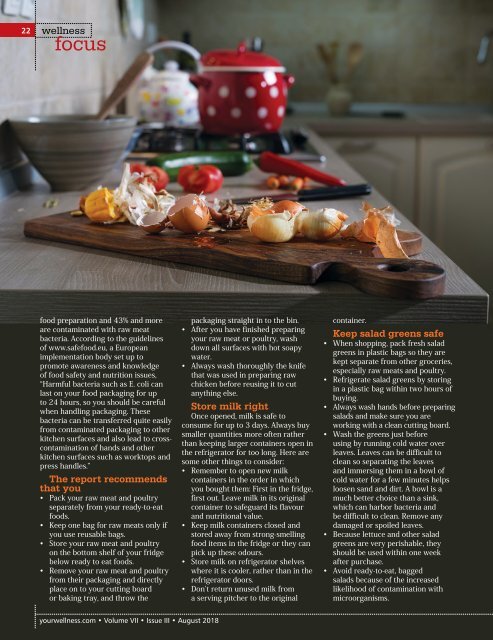You also want an ePaper? Increase the reach of your titles
YUMPU automatically turns print PDFs into web optimized ePapers that Google loves.
22 wellness<br />
focus<br />
food preparation and 43% and more<br />
are contaminated with raw meat<br />
bacteria. According to the guidelines<br />
of www.safefood.eu, a European<br />
implementation body set up to<br />
promote awareness and knowledge<br />
of food safety and nutrition issues,<br />
“Harmful bacteria such as E. coli can<br />
last on your food packaging for up<br />
to 24 hours, so you should be careful<br />
when handling packaging. These<br />
bacteria can be transferred quite easily<br />
from contaminated packaging to other<br />
kitchen surfaces and also lead to crosscontamination<br />
of hands and other<br />
kitchen surfaces such as worktops and<br />
press handles.”<br />
The report recommends<br />
that you<br />
• Pack your raw meat and poultry<br />
separately from your ready-to-eat<br />
foods.<br />
• Keep one bag for raw meats only if<br />
you use reusable bags.<br />
• Store your raw meat and poultry<br />
on the bottom shelf of your fridge<br />
below ready to eat foods.<br />
• Remove your raw meat and poultry<br />
from their packaging and directly<br />
place on to your cutting board<br />
or baking tray, and throw the<br />
packaging straight in to the bin.<br />
• After you have finished preparing<br />
your raw meat or poultry, wash<br />
down all surfaces with hot soapy<br />
water.<br />
• Always wash thoroughly the knife<br />
that was used in preparing raw<br />
chicken before reusing it to cut<br />
anything else.<br />
Store milk right<br />
Once opened, milk is safe to<br />
consume for up to 3 days. Always buy<br />
smaller quantities more often rather<br />
than keeping larger containers open in<br />
the refrigerator for too long. Here are<br />
some other things to consider:<br />
• Remember to open new milk<br />
containers in the order in which<br />
you bought them: First in the fridge,<br />
first out. Leave milk in its original<br />
container to safeguard its flavour<br />
and nutritional value.<br />
• Keep milk containers closed and<br />
stored away from strong-smelling<br />
food items in the fridge or they can<br />
pick up these odours.<br />
• Store milk on refrigerator shelves<br />
where it is cooler, rather than in the<br />
refrigerator doors.<br />
• Don’t return unused milk from<br />
a serving pitcher to the original<br />
container.<br />
Keep salad greens safe<br />
• When shopping, pack fresh salad<br />
greens in plastic bags so they are<br />
kept separate from other groceries,<br />
especially raw meats and poultry.<br />
• Refrigerate salad greens by storing<br />
in a plastic bag within two hours of<br />
buying.<br />
• Always wash hands before preparing<br />
salads and make sure you are<br />
working with a clean cutting board.<br />
• Wash the greens just before<br />
using by running cold water over<br />
leaves. Leaves can be difficult to<br />
clean so separating the leaves<br />
and immersing them in a bowl of<br />
cold water for a few minutes helps<br />
loosen sand and dirt. A bowl is a<br />
much better choice than a sink,<br />
which can harbor bacteria and<br />
be difficult to clean. Remove any<br />
damaged or spoiled leaves.<br />
• Because lettuce and other salad<br />
greens are very perishable, they<br />
should be used within one week<br />
after purchase.<br />
• Avoid ready-to-eat, bagged<br />
salads because of the increased<br />
likelihood of contamination with<br />
microorganisms.<br />
yourwellness.com • Volume VII • Issue III • <strong>August</strong> <strong>2018</strong>



